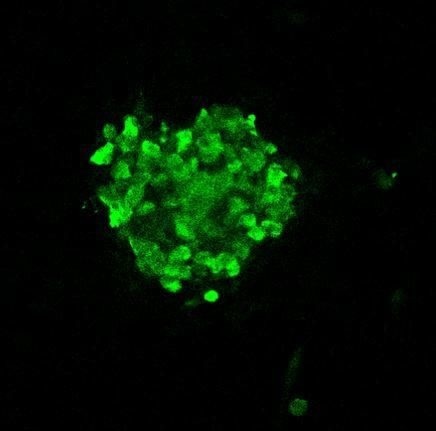Biomarkers are extremely useful tools that enable doctors to research biology and disease by, for instance, diagnosing a disease from a blood or tissue sample, predicting whether a treatment will be beneficial in a person, or determining how much of a drug is entering diseased cells.
 BOCTAG used on cancer cells to stain them green. Image Credit: Emily Oswald, Texas A&M Engineering
BOCTAG used on cancer cells to stain them green. Image Credit: Emily Oswald, Texas A&M Engineering
However, identifying these biomarkers is difficult. To aid in disease diagnosis, scientists must pinpoint proteins that are only produced by diseased or malignant cells and are not secreted by healthy ones.
The scientists devised a new method for identifying proteins generated by a specific type of cell in a complex environment with many other cell types in their work, which was published in Nature Communications.
When you have a sample containing various cell lines, it is very difficult to identify the proteins that came from a specific line. Of course, in the laboratory, we can create experiments with only one type of cell, however, these conditions do not mirror what happens in the body where complex interactions between cells could affect their behavior and so the proteins they release.”
Ben Schumann, Study Lead Author and Group Leader, Francis Crick Institute
Ben Schumann is also associated with the Imperial College London.
The new technology is based on attaching chemical tags to sugar molecules that are then delivered to cells. While all cells take the sugar, the scientists genetically alter the cell type they want to examine so that it is the only one that adds the sugar to its proteins. When the cells produce these proteins, they retain the chemical tag, allowing researchers to distinguish them.
The process employs bioorthogonal or “click” chemistry, which was given the Nobel Prize in Chemistry this year. Carolyn Bertozzi of Stanford University, one of the prize winners, is a co-author of this paper. The chemical tag is chosen so that it “clicks” with another molecule, allowing scientists to extract the appropriate proteins or tag them with a fluorescent tag.
The researchers demonstrated that their method, known as Bio-Orthogonal Cell line-specific Tagging of Glycoproteins (BOCTAG), functioned in cell cultures containing various cell lines as well as in mice, where they effectively tagged proteins from distinct cancer cells.
In this study, we looked at proteins made by cancer cells, but our method could also be used in other fields including immunology or the study of infectious disease. It could also be used to better understand disease biology, including how tumor cells change as a result of complex interactions in the body.”
Anna Cioce, Study First Author and Postdoctoral Training Fellow, Francis Crick Institute
Ben concludes, “The next step for our team will be to continue developing this method and learning more about how cells produce different proteins depending on their environment.”
Source:
Journal reference:
Cioce, A., et al. (2022) Cell-specific bioorthogonal tagging of glycoproteins. Nature Communications. doi.org/10.1038/s41467-022-33854-0.